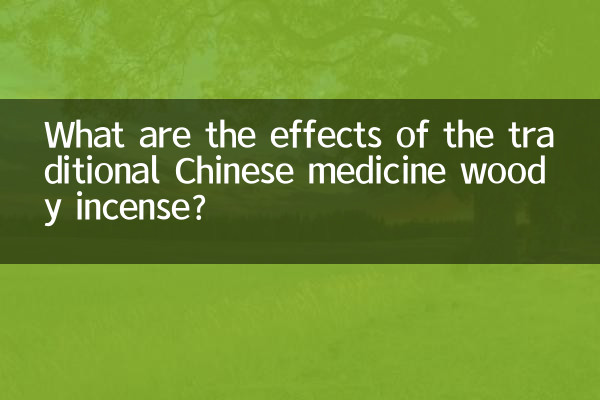What are the effects of the traditional Chinese medicine woody incense?
In recent years, as people's attention to traditional Chinese medicine continues to increase, the traditional Chinese medicine costus has become one of the hot topics due to its unique medicinal value. This article will combine the hot content of the entire Internet in the past 10 days to analyze in detail the efficacy, application and precautions of costumia. It will also be presented through structured data to help readers fully understand this traditional Chinese medicinal material.
1. Basic information about woody scent

Aucklandia lappa, whose scientific name is Aucklandia lappa, is the dried root of the Asteraceae plant Aucklandia lappa. It is mainly produced in Yunnan, Sichuan and other places in China. It is warm in nature, pungent and bitter in taste, and returns to the spleen, stomach, and large intestine meridians. It is one of the commonly used Qi-regulating drugs in traditional Chinese medicine.
| Properties | Details |
|---|---|
| scientific name | Aucklandia lappa |
| Sexual taste | pungent, bitter, warm |
| Meridian tropism | Spleen, Stomach, Large Intestine Meridians |
| Main origin | Yunnan, Sichuan |
2. The main functions of woody incense
Costus is widely used in clinical TCM, and its main functions include regulating qi and relieving pain, strengthening the spleen and eliminating food, and being antibacterial and anti-inflammatory. The following are the specific effects of woody incense and corresponding application scenarios:
| Efficacy | Application scenarios | Modern research support |
|---|---|---|
| Regulate qi and relieve pain | Relieve epigastric distension and pain, chest and hypochondrium distension and tightness | Woody essential oil can inhibit smooth muscle spasm |
| Strengthen the spleen and eliminate food | Improve loss of appetite and indigestion | Promote gastric juice secretion and enhance gastrointestinal motility |
| Antibacterial and anti-inflammatory | Adjuvant treatment of intestinal infections | It has inhibitory effect on Staphylococcus aureus, etc. |
| Regulate immunity | Enhance body resistance | Woody polysaccharides have immunomodulatory effects |
3. Clinical application of costus
Costus is often used in combination with other traditional Chinese medicines. The following are several common combination schemes and their indications:
| Compatibility plan | Indications | Usage and dosage |
|---|---|---|
| Woody + Amomum villosum | Abdominal bloating and vomiting caused by stagnation of spleen and stomach qi | 3-6 grams each, decoction in water and taken |
| Woody scent + Coptis chinensis | Damp-heat dysentery, tenesmus | 6 grams of woody incense, 9 grams of coptis chinensis |
| Woody scent + Codonopsis pilosula | Spleen deficiency and qi stagnation syndrome | 6 grams of costus, 15 grams of Codonopsis pilosula |
4. Precautions when using woody incense
Although woody incense has remarkable effects, you still need to pay attention to the following points when using it:
| Things to note | Detailed description |
|---|---|
| Taboo groups | People with yin deficiency and excessive fire should use with caution; pregnant women should not use it. |
| adverse reactions | Overdose may cause nausea and dizziness |
| drug interactions | Concomitant use with atropine drugs may weaken the efficacy of the drug |
| Storage method | Store in a cool, dry place away from moisture |
5. Modern research progress of costus
In recent years, modern pharmacological research on costus has continued to deepen. The following are the latest research findings:
| Research direction | Main findings | research institute |
|---|---|---|
| anti-tumor effect | Costulin can inhibit the proliferation of various cancer cells | Chinese Academy of Medical Sciences |
| neuroprotection | Costus extract has an improving effect on Alzheimer's disease | Peking University School of Medicine |
| cardiovascular protection | Reduce myocardial ischemia-reperfusion injury | Shanghai University of Traditional Chinese Medicine |
6. Therapeutic applications of costus
In addition to its medicinal uses, woody incense can also be used in daily dietary therapy. The following are two simple and easy dietary remedies:
| Diet name | Material | Preparation method | Efficacy |
|---|---|---|---|
| Woody porridge | 10 grams of woody wood, 100 grams of japonica rice | Wood-flavored decoction and japonica rice cooked together | Strengthen the spleen and appetizer |
| woody tea | 3 grams of woody scent, 3 grams of tangerine peel | Boiling water for tea | Regulate qi and reduce swelling |
Conclusion
As a traditional Chinese medicine, the efficacy of costus in regulating qi, relieving pain, strengthening the spleen and digesting food has been clinically verified for thousands of years. Modern research has further revealed its new value in anti-tumor, neuroprotection and other aspects. When using it, you need to pay attention to syndrome differentiation and treatment, and follow the doctor's instructions to give full play to its medicinal value. With the deepening of research on the modernization of traditional Chinese medicine, this ancient medicinal material will surely radiate new vitality.

check the details

check the details